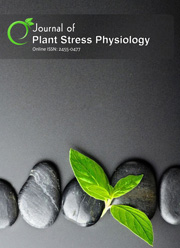Transformation of Mungbean Plants for Salt and Drought Tolerance by introducing a gene for an osmoprotectant glycine betaine
DOI:
https://doi.org/10.19071/jpsp.2017.v3.3148Abstract
Mungbean (VignaradiataL. Wilczek) is an important grain legume widely cultivated in tropical and subtropical regions of the Indian subcontinent and in South East Asian countries. Protein and carbohydrate of Mungbean are easily digestible and create less flatulence than proteins derived from other legumes.Mungbean is very sensitive to salinity, drought, high and low temperature during the flowering and seed/pod development stages resulting in heavy losses to productivity. The development of genetically engineered plants by the introduction and/or over expression of selected abiotic stress tolerant genes seems to be a viable option for obtaining improved plants. Stable transformation and expression of transgene (codA gene) was achieved in mungbean through Agrobacterium tumefaciensmediated system using cotyledonary node explants, under the optimized conditions. Molecular analysis of transgenic plants was done by using PCR, DOT-BLOT, ELISA and Western blotting. The primary transformants were checked for salt tolerance by the leaf disc test.Downloads
Download data is not yet available.
Published
20-02-2017
How to Cite
Baloda, A., S. Madanpotra, and P. aiwal. “Transformation of Mungbean Plants for Salt and Drought Tolerance by Introducing a Gene for an Osmoprotectant Glycine Betaine”. Journal of Plant Stress Physiology, vol. 3, Feb. 2017, pp. 5-11, doi:10.19071/jpsp.2017.v3.3148.
Issue
Section
REGULAR ISSUE ARTICLES






 .
.